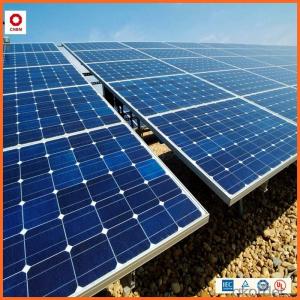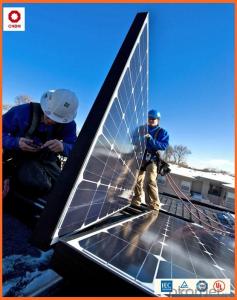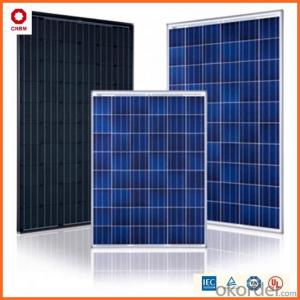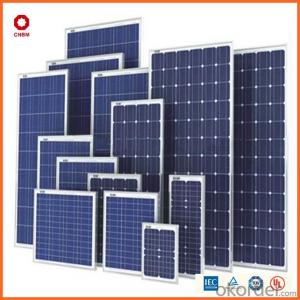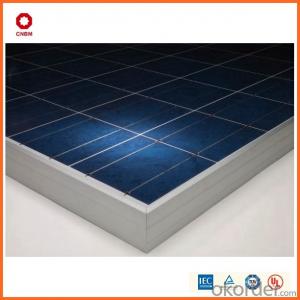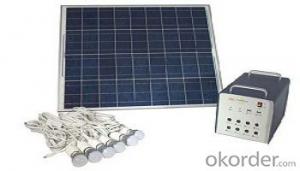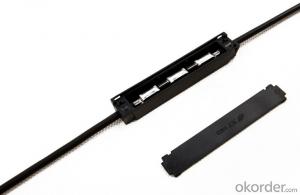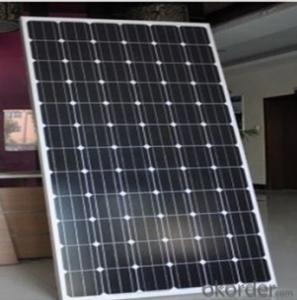!!! Hot On Sale!!! Stock 315w Poly Solar Panel USD0.46/W A Grade Good Solar Panel on Sale
- Loading Port:
- China main port
- Payment Terms:
- TT OR LC
- Min Order Qty:
- 1 watt
- Supply Capability:
- 10000000 watt/month
OKorder Service Pledge
OKorder Financial Service
You Might Also Like
Product Description:
Hot Sale !!! Quality and Safety of 245w-320w Poly Solar Panel
1. Rigorous quality control meets the highest international standards.
2. High-transmissivity low-iron tempered glass, strong aluminium frame.
3. Using UV-resistant silicon.
4. IS09001/14001/CE/TUV/UL
Warranties of 245w-320w Poly Solar Panel
1. 10 years limited product warranty
2. 15 years at 90% of the minimal rated power output
3. 25 years at 80% of the minimal rated power output
Technical date of 245w-320w Poly Solar Panel
ITEM NO.: | Mono 125*125 cell ,36pcs . Power range from 80Wp-100Wp | ||||||||
Maximum Power(W) | 80 | 85 | 90 | 95 | 100 | ||||
Optimum Power Voltage(Vmp) | 17.81 | 17.89 | 17.94 | 17.99 | 18.06 | ||||
Optimum Operatige Current(Imp) | 4.78 | 4.91 | 5.12 | 5.35 | 5.59 | ||||
Open Circuit Voltage(Voc) | 21.98 | 22.05 | 22.14 | 22.28 | 22.45 | ||||
Short Circuit Current(Isc) | 4.95 | 5.15 | 5.36 | 5.65 | 5.84 | ||||
Solar Cell: | 125*125 Mono | ||||||||
Number of Cell(pcs) | 4*9 | ||||||||
Brand Name of Solar Cells | JA Cell, Bluesun Cell | ||||||||
Size of Module(mm) | 1580*808*35 | ||||||||
Caple & Connector Type | Pass the TUV Certificate | ||||||||
Frame(Material Corners,etc.) | Aluminium-alloy | ||||||||
Backing (Brand Type) | TPT | ||||||||
Cell Efficiency for 100W(%) | 15.8% | ||||||||
Weight Per Piece(KG) | 12.0KG | ||||||||
FF (%) | 70-76% | ||||||||
Junction Box Type | Pass the TUV Certificate | ||||||||
Tolerance Wattage(e.g.+/-5%) | ±3%, or 0-3% | ||||||||
Front Glass Thikness(mm) | 3.2 | ||||||||
Temperature Coefficients of Isc(%) | +0.04 | ||||||||
Temperature Coefficients of Voc(%) | -0.38 | ||||||||
Temperature Coefficients of Pm(%) | -0.47 | ||||||||
Temperature Coefficients of Im(%) | +0.04 | ||||||||
Temperature Coefficients of Vm(%) | -0.38 | ||||||||
Temperature Range | -40°C to +85°C | ||||||||
Surface Maximum Load Capacity | 2400Pa | ||||||||
Allowable Hail Load | 23m/s ,7.53g | ||||||||
Bypass Diode Rating(A) | 12 | ||||||||
Warranty | 90% of 10 years,80% of 25 years. | ||||||||
Standard Test Conditions | AM1.5 1000W/ 25 +/-2°C | ||||||||
Packing | carton or pallet | ||||||||
1*20' | 25 Pallets / 450pcs | ||||||||
1*40'STD | 25 Pallets / 100pcs | ||||||||
Features of our products:
• High conversion efficiency mono/poly-crystalline amorphous silicon solar cells
• Modules incorporate high performance bypass diodes to minimize the power drop caused by shading
• High transmittance, low-iron tempered glass
• High performance EVA encapsulant to prevent destroying and water.
• AI frame: without screw, corner connection. 8 holes on the frame can be installed easily
• Good performance of preventing from atrocious weather such as wind and hails
• Certifications: CE IEC TUV VDE UL, Class I
• 10 years 90% power output warranty

Shipping of 245w-320w Poly Solar Panel
By Sea | Delivery from Shanghai or Ningbo seaport |
By Air | Departure from Shanghai Pudong Airport |
By Express | Post by DHL, EMS, UPS, TNT. |
- Q:How do solar energy systems impact the reliability of the electricity grid?
- Solar energy systems can have both positive and negative impacts on the reliability of the electricity grid. On one hand, solar energy systems can enhance grid reliability by diversifying the energy sources and reducing reliance on traditional fossil fuel-based power plants. This can help prevent power outages and reduce the vulnerability of the grid to disruptions. Additionally, solar energy systems can contribute to the decentralization of power generation, empowering communities and reducing the risk of widespread blackouts. On the other hand, solar energy systems also pose challenges to grid reliability. Their intermittent nature, as solar power generation depends on sunlight availability, can create fluctuations in the supply of electricity. This intermittency requires the grid to be more flexible and adapt quickly to varying solar output. To ensure grid stability, additional measures such as energy storage systems and advanced grid management technologies may be necessary. Overall, the impact of solar energy systems on grid reliability depends on various factors such as the level of solar penetration, grid infrastructure, and the implementation of supportive policies and technologies. With proper planning and integration, solar energy systems can contribute to a more reliable and resilient electricity grid.
- Q:How long does it take for a solar energy system to pay for itself?
- The payback period for a solar energy system varies based on several factors such as the initial cost, location, energy usage, and available incentives. On average, it takes around 5-10 years for a residential solar energy system to pay for itself through energy savings. However, this timeframe can be shorter in areas with high electricity costs and substantial government or utility incentives.
- Q:What are the components of a solar energy system?
- A solar energy system consists of several key components that work together to harness the power of the sun and convert it into usable electricity. The main components of a solar energy system include: 1. Solar Panels: These are the most recognizable element of a solar energy system. Solar panels, also known as photovoltaic (PV) panels, are made up of multiple solar cells that convert sunlight into direct current (DC) electricity. They are typically mounted on the roof or ground to capture sunlight. 2. Inverter: The DC electricity generated by the solar panels needs to be converted into alternating current (AC) electricity, which is the type of electricity used in homes and businesses. An inverter is responsible for this conversion process, ensuring that the electricity can be used by various appliances and devices. 3. Mounting System: Solar panels need to be securely mounted on rooftops or on the ground. The mounting system consists of racking or frames that hold the panels in place and allow for optimal sunlight exposure. The mounting system also ensures that the panels are installed at the correct angle and orientation to maximize energy production. 4. Electrical Wiring: Proper electrical wiring is crucial to connect the solar panels, inverter, and other components of the solar energy system. The wiring carries the electricity from the panels to the inverter, and then to the electrical panel of the building, where it can be distributed and used. 5. Batteries (Optional): In some solar energy systems, batteries are included to store excess electricity generated during the day for use during the night or during periods of low sunlight. These batteries store the excess energy and release it when needed, allowing for a more consistent and reliable power supply. 6. Monitoring System: Many solar energy systems come with a monitoring system that allows users to track the performance and energy production of their system. This can be done through a web-based platform or a smartphone app, providing real-time data on energy generation, consumption, and savings. 7. Grid Connection (Optional): Solar energy systems can be connected to the electrical grid, allowing excess electricity to be fed back into the grid when the system produces more energy than is being used. This is known as net metering, and it allows homeowners to earn credits or receive compensation for the excess energy they generate. Overall, a solar energy system is a complex and interconnected set of components that work together to harness the sun's energy and convert it into usable electricity for various applications. These components enable individuals and businesses to reduce their reliance on traditional fossil fuel-based energy sources and contribute to a cleaner and more sustainable future.
- Q:How do solar energy systems impact energy access in developing countries?
- Solar energy systems have a significant positive impact on energy access in developing countries. These systems provide a clean, sustainable, and affordable source of electricity, especially in remote areas where grid infrastructure is limited or non-existent. Solar energy helps bridge the energy gap, enabling communities to power their homes, schools, and businesses, improving their quality of life. Additionally, solar energy systems reduce reliance on fossil fuels, contributing to environmental preservation and mitigating climate change effects.
- Q:Can a solar energy system be installed in a coastal area?
- Yes, a solar energy system can be installed in a coastal area. In fact, coastal areas can be ideal for solar installations due to the abundance of sunshine and the potential for strong winds, which can help keep the solar panels cool and increase their efficiency. However, it's important to consider the potential impact of saltwater corrosion on the system's components and to use appropriate materials and maintenance practices to ensure its longevity.
- Q:Can solar energy systems be used for powering aquaculture systems?
- Yes, solar energy systems can be used to power aquaculture systems. Solar energy is a renewable and sustainable source of power that can be harnessed and used to generate electricity. This electricity can then be used to power various components of an aquaculture system, such as water pumps, aerators, heaters, and lighting. Using solar energy to power aquaculture systems offers several advantages. Firstly, it reduces reliance on traditional fossil fuels, which are finite and contribute to environmental pollution and climate change. By using solar power, aquaculture systems can significantly reduce their carbon footprint and contribute to a cleaner and greener energy future. Secondly, solar energy is readily available in many parts of the world. By harnessing the power of the sun, aquaculture systems can operate independently of the grid and remote locations can also benefit from sustainable aquaculture practices. Thirdly, solar energy systems offer cost savings in the long run. While the initial setup and installation costs may be higher compared to traditional energy sources, the operational costs of solar energy systems are significantly lower. Solar power is essentially free once the system is installed, and maintenance costs are minimal. This can lead to substantial savings over time, making solar-powered aquaculture systems a cost-effective choice. Lastly, solar energy systems can be integrated with other renewable energy technologies, such as battery storage systems. This allows excess solar energy to be stored and used during periods of low sunlight, ensuring a consistent and reliable power supply for aquaculture systems. Overall, solar energy systems can effectively power aquaculture systems, offering numerous benefits including environmental sustainability, energy independence, cost savings, and integration with other renewable energy technologies.
- Q:Can solar energy systems be used in powering wineries or breweries?
- Yes, solar energy systems can definitely be used to power wineries or breweries. In fact, many wineries and breweries around the world have already embraced solar power as a sustainable and cost-effective energy source. Solar energy systems can be installed on the rooftops or surrounding areas of these facilities to capture sunlight and convert it into electricity. The electricity generated from solar panels can be used to power various aspects of winemaking or brewing operations, such as lighting, heating, cooling, and machinery. It can also be used to run pumps for irrigation or ventilation systems, which are crucial for maintaining the ideal conditions for the fermentation process. Using solar power not only helps wineries and breweries reduce their carbon footprint and dependence on fossil fuels but also offers several financial benefits. Solar energy systems can significantly lower utility bills, as wineries and breweries often require a substantial amount of electricity to operate. Additionally, some regions offer incentives and tax credits for businesses that adopt renewable energy sources like solar power. Moreover, solar energy systems can provide wineries and breweries with energy independence and reliability. They can generate electricity even during power outages or during peak demand periods when electricity prices are higher. This ensures uninterrupted production and reduces the vulnerability of these facilities to energy shortages or price fluctuations. Overall, solar energy systems have demonstrated their effectiveness in powering wineries and breweries, offering environmental, financial, and operational advantages. By harnessing the power of the sun, these industries can contribute to a more sustainable future while enjoying the numerous benefits of solar energy.
- Q:Can solar energy systems be connected to the existing power grid?
- Solar energy systems can indeed be linked to the current power grid, known as grid-tied or grid-connected solar systems. In this configuration, solar panels harness sunlight to generate electricity, which is then converted by inverters into usable AC power. This AC power is then integrated into the existing power grid, effectively supplementing the utility company's electricity supply. Grid-tied solar systems provide multiple advantages. Primarily, they allow homeowners and businesses to decrease their dependence on fossil fuel-based electricity and reduce their carbon footprint. Moreover, any surplus electricity generated by the solar panels can be returned to the grid, resulting in net metering or feed-in tariffs. In this scenario, the excess power is credited to the system owner by the utility company, leading to substantial cost savings or even potential revenue generation. Furthermore, grid-tied systems ensure a reliable and consistent supply of electricity. During periods when the solar panels are unable to generate sufficient power, such as at night or during cloudy weather, electricity can be acquired from the grid. Conversely, when the panels produce more electricity than is being utilized, the surplus is sent back to the grid, guaranteeing an uninterrupted and continuous power supply. It is important to acknowledge that the installation and connection of grid-tied solar systems may necessitate the approval and coordination of the local utility company, as well as adherence to pertinent regulations and safety standards. Nevertheless, the capability to connect solar energy systems to the existing power grid renders them a versatile and advantageous renewable energy solution.
- Q:Can solar energy systems be used for powering water pumps?
- Yes, solar energy systems can be used for powering water pumps. Solar-powered water pumps utilize photovoltaic panels to convert sunlight into electricity, which can then be used to run the pumps. These systems are especially useful in remote areas where access to electricity is limited.
- Q:Can solar energy systems be used in powering restaurants or food chains?
- Yes, solar energy systems can definitely be used in powering restaurants or food chains. Solar panels can be installed on the roofs or in open spaces near the establishments to harness sunlight and convert it into electricity. This renewable energy source can power various operations within the restaurants, including lighting, refrigeration, cooking equipment, and HVAC systems, helping to reduce energy costs and carbon emissions. Additionally, the use of solar energy aligns with the sustainability goals of many food chains and can enhance their green reputation.
1. Manufacturer Overview |
|
|---|---|
| Location | |
| Year Established | |
| Annual Output Value | |
| Main Markets | |
| Company Certifications | |
2. Manufacturer Certificates |
|
|---|---|
| a) Certification Name | |
| Range | |
| Reference | |
| Validity Period | |
3. Manufacturer Capability |
|
|---|---|
| a)Trade Capacity | |
| Nearest Port | |
| Export Percentage | |
| No.of Employees in Trade Department | |
| Language Spoken: | |
| b)Factory Information | |
| Factory Size: | |
| No. of Production Lines | |
| Contract Manufacturing | |
| Product Price Range | |
Send your message to us
!!! Hot On Sale!!! Stock 315w Poly Solar Panel USD0.46/W A Grade Good Solar Panel on Sale
- Loading Port:
- China main port
- Payment Terms:
- TT OR LC
- Min Order Qty:
- 1 watt
- Supply Capability:
- 10000000 watt/month
OKorder Service Pledge
OKorder Financial Service
Similar products
New products
Hot products
Hot Searches
Related keywords
